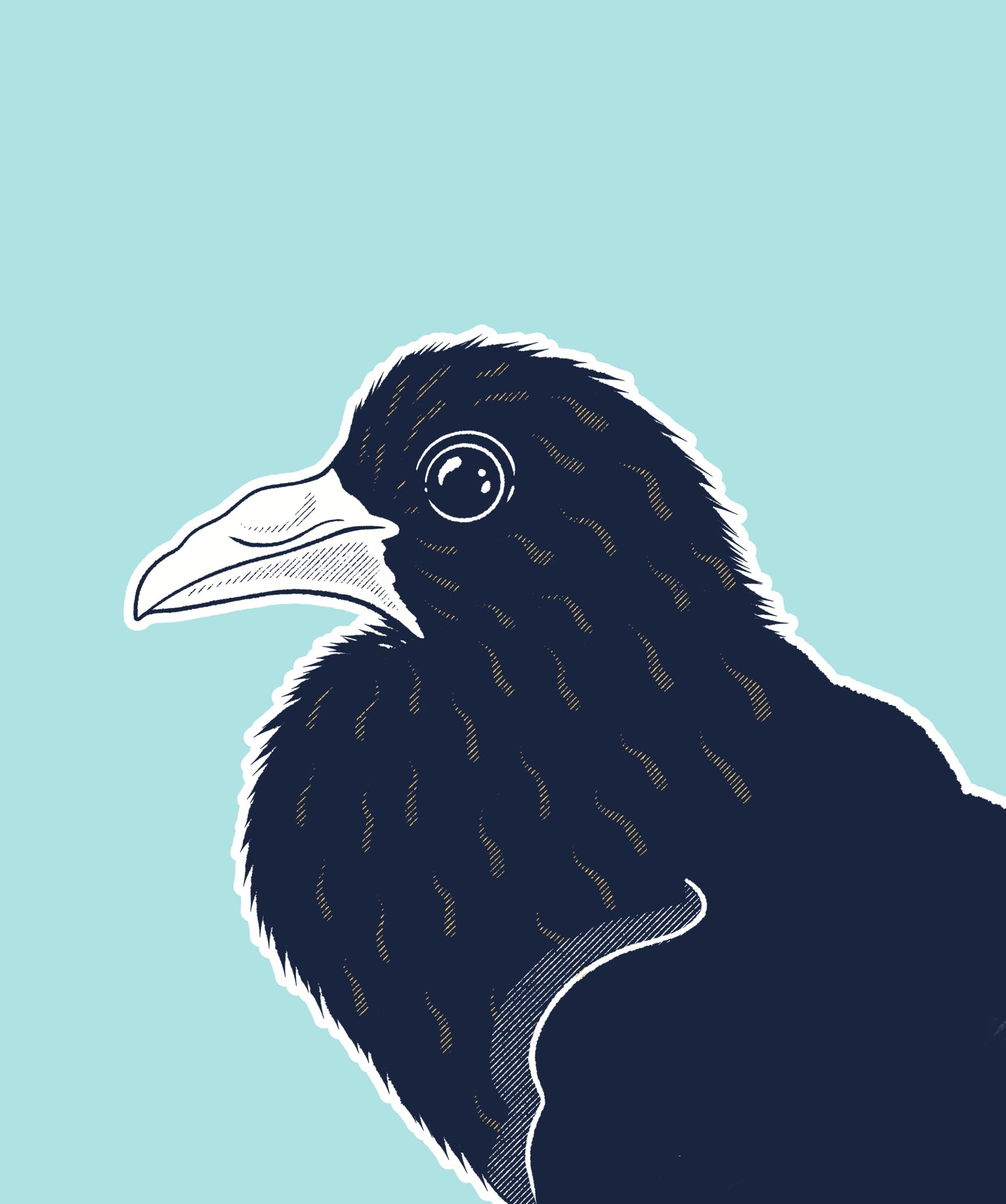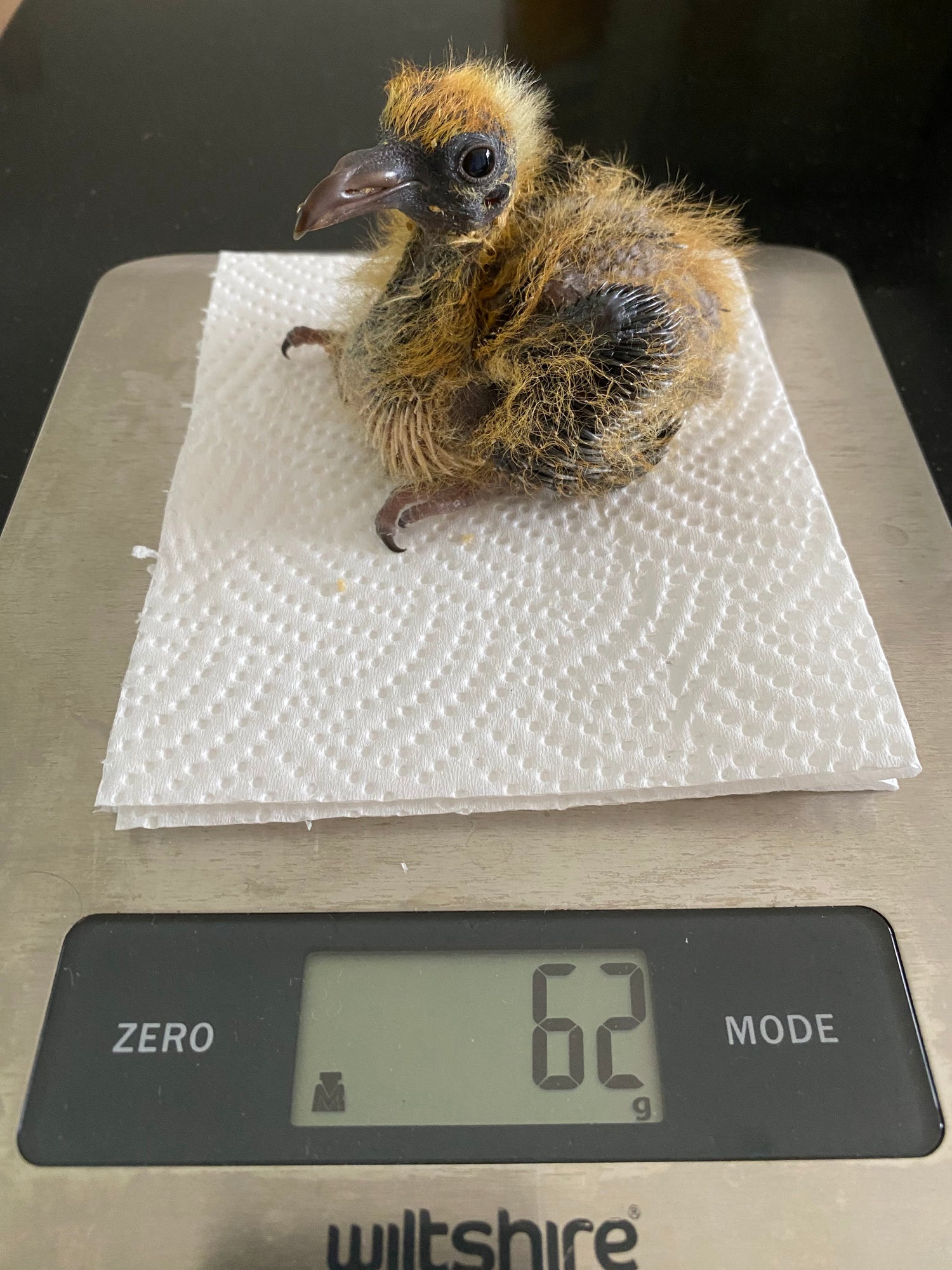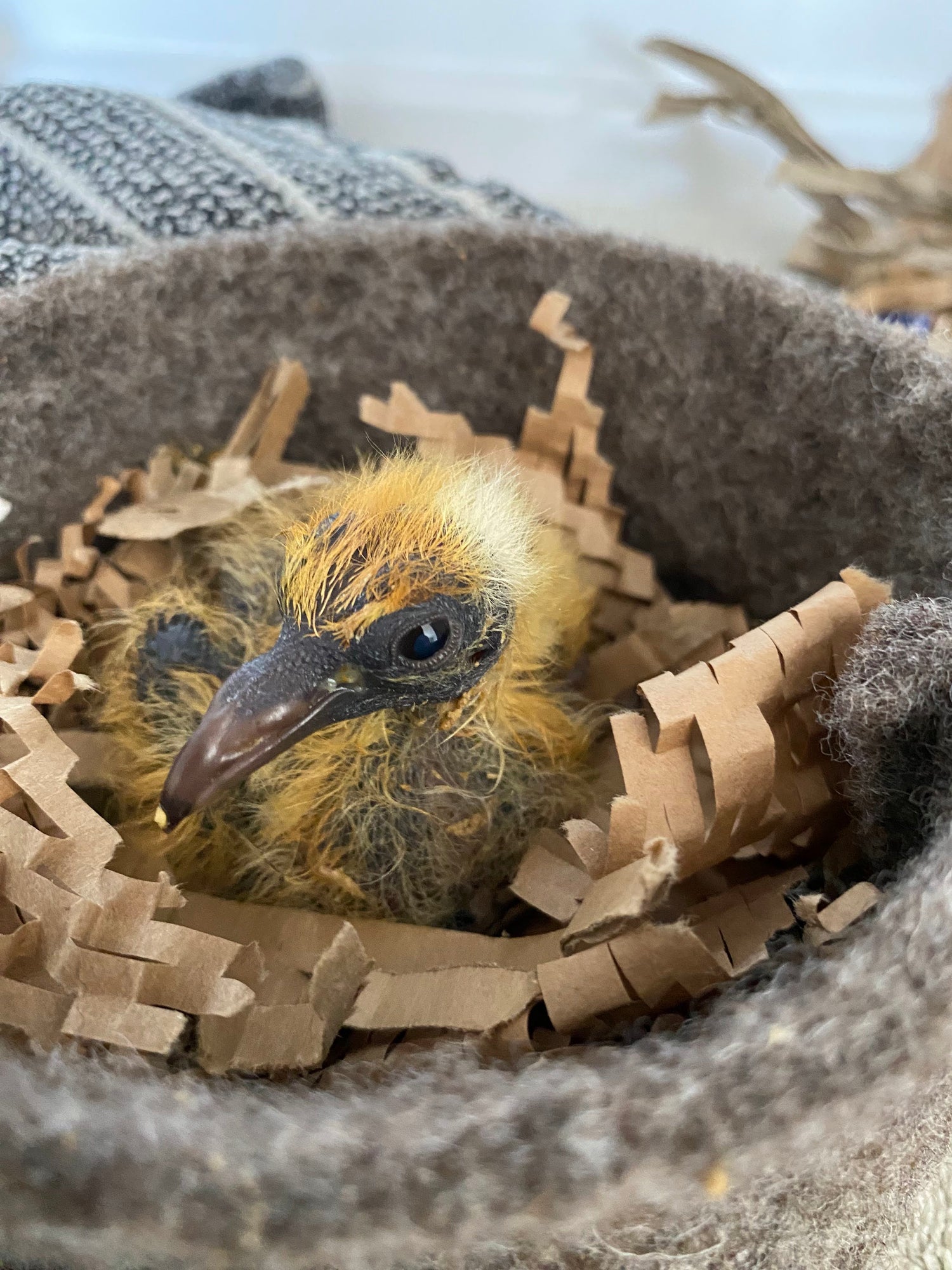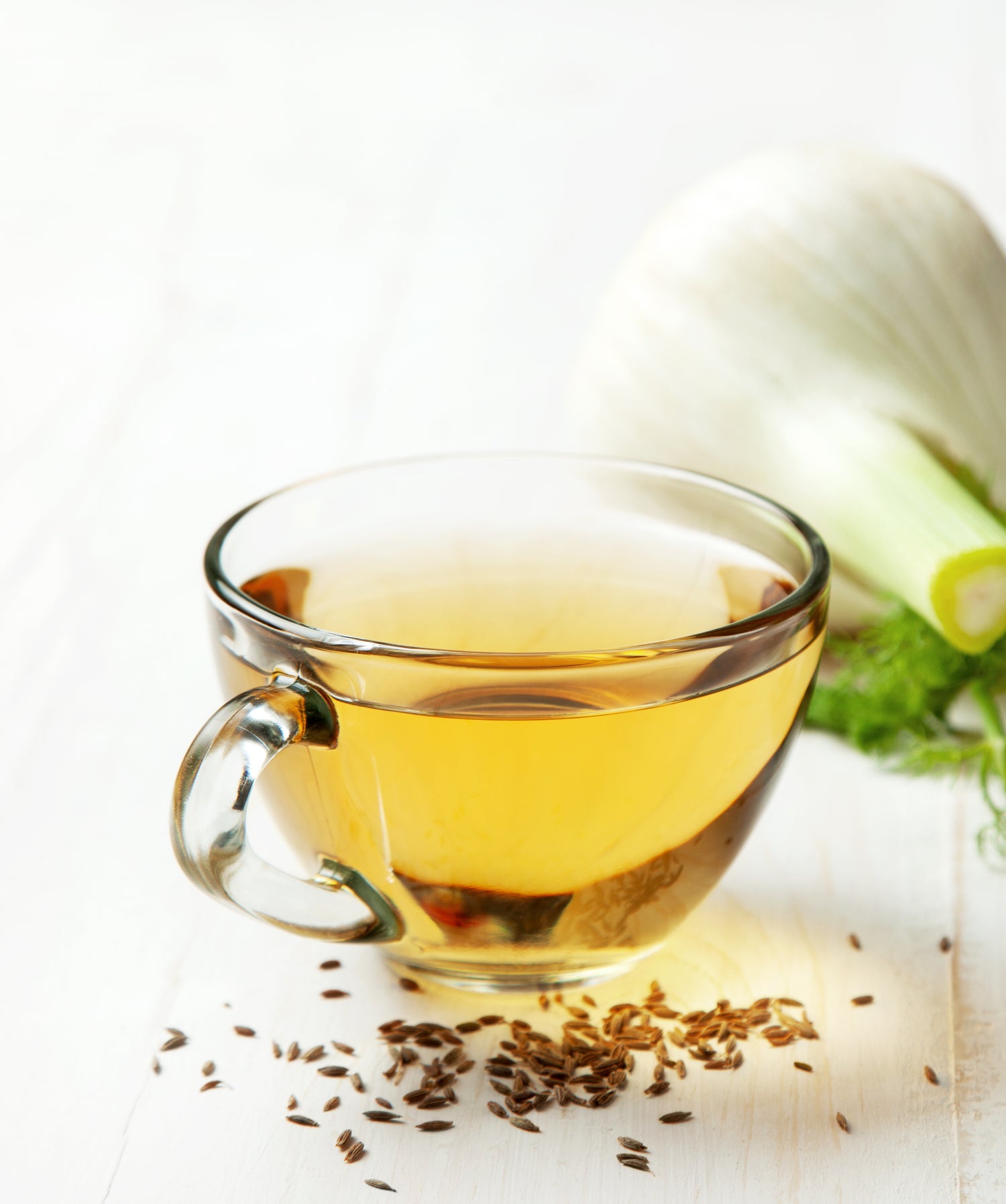

Hand rearing guide for Pigeons (Squabs)
Introduction: It is always best for a baby pigeon (squab) to be raised by its parents or, when that's not possible, by an experienced wildlife rehabilitator. Parental care provides ideal nutrition, warmth, and behavioural development that is difficult to replicate. However, emergencies happen, and sometimes you're the only one available to help.
This manual is designed to guide you through the basics of hand-rearing a baby pigeon safely and compassionately. Whether you’ve found a nestling in need or are stepping in temporarily, this resource will give you the tools and knowledge to give the bird the best possible start.
Disclaimer: This is a basic guide and doesn’t cover every issue that can arise when hand-rearing pigeons. It’s based on what’s worked best for us through experience and research. If you have any questions, feel free to email, we’re happy to help.
Checklist
Collapsible content
1ml Syringe
When it comes to clean and accurate feeding, I find syringes to be the easiest and most reliable option. That said, if you’re more comfortable using a crop needle or silicone tube, go for it! The most important thing is that the bird gets the right food into the crop, not all over their face.
Sterilising Soltion
Proper cleaning of feeding tools is essential when hand-rearing baby birds to prevent harmful bacteria buildup. I recommend soaking syringes, feeding tubes, and any reusable equipment in a Milton solution for 20 minutes, then rinsing thoroughly and leaving them to air dry. Having a dedicated cleaning routine and the right supplies on hand ensures safe, hygienic feeding every time
Heat Source
There are several heating options available, each with its pros and cons, plant propagation heat mats, SnuggleSafe discs, incubators, wheat bags, and hot water bottles can all be used depending on your setup and the bird’s needs.
Nest Setup
Use a knitted nest, small bowl or container lined with soft, supportive, and foot-safe materials to prevent splayed legs. Good options include:
- Tissue, especially for the early stages.
- Ripped up paper towel.
- Paper towels.
- Rolled-up gauze (use with caution loose threads)
- Textured fabrics (use with caution loose threads)
- Honeycomb expanding packing wrap.
Avoid slippery surfaces or anything the bird's legs can sink into or get caught on ie loose threads. Replace nesting material frequently to keep the area clean and dry.
Food Supplies
Feeding supplies – either a quality premade formula or a safe homemade mix.
Digital Thermometer
Digital thermometer – to ensure formula is at the correct temperature (38–41°C)
Small Kitchen Scales
Small kitchen scales – for daily weight tracking.
High Quality Bird Multivitamin
This will help support development, especially if the diet lacks variety. We have an excellent bird specific multivitamin that you can purchase here
Toys and a Mirror
This can provide important enrichment, especially for solo chicks to prevent loneliness and encourage natural behaviours.
Important Daily Tasks

- Monitor weights: Weigh the bird each morning before feeding and keep a written record. This helps calculate daily food needs and track growth.
- Monitor droppings, they will be the first indicator that things aren't going well.
- Watch the crop: Ensure the crop empties fully between feeds. If it’s not emptying well, adjust feeding or seek support.
- Check leg development: Make sure the legs are positioned correctly and not splaying.
- Keep the nest clean: Change bedding often. Droppings left in the nest can burn the skin and cause infections.
- Early intervention matters: Address any changes in behaviour, weight, or posture promptly.
- Keep handling to a minimum, Avoid over-interacting with birds you’re raising, as excessive human contact can reduce their chances of successfully being released. If you only have one bird, provide comfort and stimulation with items like soft toys or mirrors, rather than direct human bonding.
Key Feeding Rules
-
- The crop can hold approximately 10–12% of a bird’s body weight at any one time.
-
- baby pigeon typically needs to consume 60–70% of its body weight in food each day to support healthy growth.
-
- Food should only be given when the crop is close to empty to prevent overfilling and digestive issues.
-
- Always warm the formula to 38–41°C using a digital thermometer before feeding. Discard any unused formula after one hour.
Food Options
-
Commercially Available Options day 1 - 30
- Higgins Intune hand feeding formula
- Kaytee Exact
- Passwells hand rearing food
- Roudybush hand rearing formula
- Vetafarm Neocare
-
Crop Milk Replacer Recipe For Day 1 - 3
Ingredients:
- 1 small jar (70 g) plain chicken baby food (ingredients: should be just chicken + water or similar)
- 1 tablespoon plain, unsweetened greek yoghurt (no added sugar or flavouring)
- 1 ml flaxseed oil, olive oil or cooked egg yolk.
- Bird multivitamin (follow the label)
- Bird Probiotics (follow the label)
- 100–150 mg elemental calcium (¼ tsp ground calcium carbonate) Please note, some may be found in the multivitamin
Instructions for mix:
- Mix all ingredients thoroughly and store this mix in the fridge.
- Warm what you need to 38–41°C, checking with a digital thermometer.
- Feed using a syringe.
- Discard any leftovers after one hour.
-
Home Made Rearing Recipe For Day 3 - 30
Ingredients:
- 2 tbsp baby rice cereal (e.g. Farex or equivalent, iron-fortified is fine)
- 1 tbsp plain, unsweetened greek yoghurt (no added sugar or flavouring)
- Bird multivitamin (follow the label)
- Bird Probiotic (follow the label)
- 1 tsp flaxseed oil, olive oil, cooked egg yolk (for healthy fats)
- Optional: 1 tbsp cooked peas, lentils or cooked egg white blended smooth (for extra protein)
Instructions for mix:
- Mix rice cereal with water to make a smooth porridge-like consistency.
- Blend in yoghurt, oil, and multivitamin supplement. Store this mix in fridge.
- Warm what you need to 38–41°C, checking with a digital thermometer.
- Feed using a syringe.
- Discard leftovers after 1 hour; do not reheat or reuse.
-
Day 14 onwards (Seed and water should become available)
A high-quality commercial pigeon mix should be balanced, species-appropriate, and tailored to the bird's life stage, activity level, and season
Base Grains (60–70%)
- Wheat – Energy-rich, easily digestible
- Maize (corn) – Cracked or whole; adds energy
- Barley – Adds bulk, helps with digestion (in moderation)
- Milo (sorghum) – Good energy source
- Oats (hulled or groats) – High in fibre and fat
Protein-Rich Legumes (20–30%)
- Peas (green, maple, or yellow) – Common in pigeon mixes
- Lentils – Easier to digest than peas, good for variety
- Vetch – Rich in protein and fibre
- Faba beans – Used in small amounts in some high-performance mixes.
Oil Seeds (5–10%)
- Safflower – Source of healthy fat and vitamin E
- Sunflower (black or striped, hulled for smaller birds) – High energy
- Canola/Rape seed or Linseed (flaxseed) – Small seeds rich in omega-3s
Additions for Performance or Specific Needs.
- Popped corn or popcorn maize – Light and digestible
- Pigeon pellets – For extra vitamins, minerals, and amino acids
- Condition seeds – Like aniseed or fennel, often in small quantities
- Pelleted grit/calcium chips – Sometimes added, but usually offered separately
IMPORTANT: Don’t cut corners, feeding formula that’s too cold, too hot, or reheated can cause crop slowdown and lead to serious complications.
Care By Weight
Collapsible content
15g
Age (estimation): 0 - 1 day
Volume per feed: 1.5 - 2ml
Feeds per day: 6 - 7
Temperature: 36 - 37.2℃
Humidity: 55 - 65%
25g
Age (estimation): 2 - 3 day
Volume per feed: 2.5 - 3ml
Feeds per day: 6
Temperature: 36 - 37℃
Humidity: 55 - 65%
35g
Age (estimation): 4 - 5 day
Volume per feed: 3.5 - 4ml
Feeds per day: 6
Temperature: 35.5 - 36.5℃
Humidity: 55 - 65%
45g
Age (estimation): 6 - 7 day
Volume per feed: 4.5 - 5ml
Feeds per day: 5 - 6
Temperature: 35℃
Humidity: 55 - 65%
55g
Age (estimation): 8 - 9 day
Volume per feed: 5.5 - 6ml
Feeds per day: 5
Temperature: 34.5℃
Humidity: 55 - 65%
65g
Age (estimation): 10 - 11 day
Volume per feed: 6.5 - 7ml
Feeds per day: 5
Temperature: 34℃
Humidity: 55 - 65%
75g
Age (estimation): 12 - 13 day
Volume per feed: 7.5 - 8ml
Feeds per day: 4 - 5
Temperature: 33 - 33.5℃
Humidity: 55 - 65%
85g
Age (estimation): 14 - 15 day
Volume per feed: 8.5 - 9ml
Feeds per day: 4
Temperature: 32 - 33℃
Humidity: 55 - 65%
95g
Age (estimation): 16 - 17 day
Volume per feed: 9.5 - 10ml
Feeds per day: 4
Temperature: 31 - 33℃
Humidity: 55 - 65%
105g
Age (estimation): 18 - 19 day
Volume per feed: 10 - 11ml
Feeds per day: 3 - 4
Temperature: 30 - 31℃
Humidity: 55 - 65%
115g
Age (estimation): 20 - 21 day
Volume per feed: 11 - 12ml
Feeds per day: 3 - 4
Temperature: 29 - 30℃
Humidity: 55 - 65%
125g
Age (estimation): 22 - 23 day
Volume per feed: 12 - 13ml
Feeds per day: 3
Temperature: 28 - 29℃
Humidity: 55 - 65%
135g
Age (estimation): 24 - 25 day
Volume per feed: 12 - 13ml
Feeds per day: 3
Temperature: 27 - 28℃
Humidity: 55 - 65%
145g
Age (estimation): 26 - 27 day
Volume per feed: 14 - 15ml
Feeds per day: 3
Temperature: 26 - 27℃
Humidity: 55 - 65%
155g
Age (estimation): 28 - 29 day
Volume per feed: 15 - 16ml
Feeds per day: 2 - 3
Temperature: 24 - 26℃
Humidity: 55 - 65%
Step by Step: How to Feed

1. Prepare the formula – Mix to the correct temperature (38–41 °C) and age-appropriate consistency.
2. Choose the right syringe – Use a clean, food-grade syringe (1 ml for precision) or a syringe fitted with a crop needle, whichever you find safest and easiest to handle.
3. Encourage the feeding response – Position two fingers gently on either side of the beak. This often triggers the chick’s natural instinct to open its mouth and get ready to swallow.
4. Insert the syringe tip – Place it into the mouth, aiming towards either the right or left side of the throat. This helps avoid the airway opening (glottis) at the base of the tongue.
5. Feed slowly – Depress the plunger steadily, allowing the bird to swallow (you’ll see a gentle head-bobbing motion) between small amounts. Watch the crop fill, it should feel like a soft, full pouch, never hard or overly tight.
6. Avoid overfilling – The crop should hold roughly 10–12 % of the bird’s body weight per feed.
7. Clean up – Gently wipe away any formula from feathers or beak (dried formula can damage adult feathers) and thoroughly rinse all feeding equipment.
Slow Crop Tips

A slowing crop can be a concern in young birds, even when everything is done correctly, appropriate temperature, fresh formula, and correct feeding amounts. I’ve found that mixing the following into the water used for feeds, or offering a small in-between gavage with apple cider vinegar or fennel tea, can help naturally stimulate crop movement and support healthy digestion.
Apple Cider Vinegar (ACV):
Helps maintain a healthy crop environment by lowering pH and reducing harmful
bacteria. When preparing water for homemade formula, add 5 ml of ACV per 1
litre of water, or aim for a pH of 5–6, which you can check using a
pool test strip.
Fennel Tea or Seeds:
Fennel supports healthy crop motility and can be especially useful in cases of
slow crop. Brewed fennel tea/seeds can be used as the water base for your formula, or
mixed with ACV to combine benefits.
References
- Walker, Dr Colin. The Pigeon – A Veterinary Book. Pigeon Racing Victoria, Melbourne.
- Duerr, Rebecca S., and Laurie J. Gage, editors. Hand-Rearing Birds. 2nd ed., Wiley-Blackwell, 2020.

